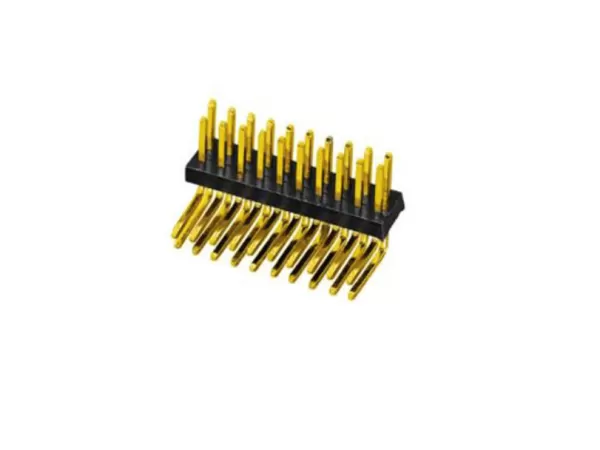Stable connection starts with high-quality pin headers

Technical analysis of pin header connectors: design, performance and application
Pin header is a connector widely used in electronic circuits, mainly used to connect electrical signals or power between circuit boards and other components, devices or circuits. As an indispensable part of electronic design, pin headers are widely used in many fields such as industry, communications, consumer electronics, and automobiles due to their stability, reliability, and ease of use. This article will explore the technical principles, design elements, common types, and applications of pin headers.
1. The basic principle of pin header connector
The main function of the pin header connector is to connect the signal or power on the circuit board to other devices through the plug. It usually consists of two parts: metal pins and a plastic base . The metal pins are used to conduct electrical signals or power, and the plastic base provides mechanical support to ensure the stability and durability of the connector.
The working principle of the pin header connector is very simple. When the plug is inserted into the pin header, the metal pins contact the contact ends in the plug to form an electrical connection. Depending on the design, the pin header connector can support a variety of interface types, including single row, double row, and different pitches to meet different design requirements.
2. Design elements of pin header connector
When designing a pin header connector, there are several important parameters to consider to ensure its performance and stability in actual application:
1. Pitch
Pin pitch refers to the distance between two adjacent pins in the connector. Common pin pitches are 2.54mm , 1.27mm , 2.00mm , etc. For this reason, we also have 1.00MM, 0.8MM, etc. The choice of pin pitch directly affects the density of the pin header connector and the compatible equipment. A smaller pin pitch is suitable for high-density design, while a larger pin pitch helps reduce electrical interference and improve stability.
2. Number of pins
The number of pins on a pin header connector usually matches the interface requirements of the circuit board. The number of pins can range from a few to dozens, depending on the number of signals or power supplies that need to be connected. When designing, it is necessary to decide based on the specific circuit board layout, functional requirements, and space limitations.
3. Plastic base height (plastic height)
The height of the plastic base of the pin header connector affects the convenience of plugging and unplugging operations and the stability of electrical contact. The common plastic height range is between 2.5mm and 5mm . Depending on the application, choosing the right plastic height can ensure smooth plugging and unplugging of the connector and provide sufficient mechanical support.
4. Materials and surface treatment
The material of the pin header is usually made of copper alloy , phosphor copper or stainless steel to ensure good electrical conductivity. In order to improve corrosion resistance and reduce contact impedance, many pin header connectors are tin-plated, gold-plated or nickel-plated. Gold-plated pin headers are often used in high-end applications due to their superior conductivity and high oxidation resistance.
3. Common types of pin header connectors
1. Single row pin header
Single row pin header is a common pin header connector type suitable for single connection of signal and power. Single row design is simple, occupies less space, suitable for electronic devices that require low connection density.
2. Double row pin header
Double-row pin headers have two rows of pins and are suitable for scenarios that require more connection points, which can effectively increase the connection density of the circuit board. Due to its high connection density, double-row pin headers are suitable for designs where space is limited but multiple signal inputs and outputs are required.
3. Through-hole and surface mount (SMD)
- In-line pin headers are the most common type of pin headers, where the pins are soldered through circuit board holes and are suitable for most traditional circuit board designs.
- Surface mount pin headers are soldered to the surface of the circuit board, suitable for automated production and miniaturized design, and suitable for modern SMT (surface mount technology) production processes.
4. High density pin header
High-density pin headers achieve a more compact design through a smaller pin pitch (e.g. 1.27mm or less), and are suitable for application scenarios with high connection density requirements, such as high-frequency communication equipment and miniaturized electronic devices.
4. Application fields of pin header connector
Pin header connectors are widely used in many industries due to their high reliability, customizability and easy assembly:
1. Communications industry
Pin header connectors are widely used in communication equipment such as routers, switches, base stations, etc., providing a stable signal transmission interface.
2. Consumer electronics
In consumer electronic products such as mobile phones, televisions, and stereos, pin header connectors are used to connect the motherboard to various components to ensure power supply and signal transmission of the device.
3. Industrial Automation
In automation equipment, pin header connectors are used to connect key components such as sensors, actuators, and controllers to ensure stable operation of the equipment.
4. Automotive electronics
In modern cars, pin header connectors are used to connect on-board control systems, sensors, and other electronic devices to ensure vehicle safety and efficiency.
5. Medical devices
In precision equipment such as medical instruments and diagnostic equipment, pin header connectors are used to ensure accurate signal transmission and high stability of the equipment.
Choosing the right pin header connector can not only ensure the stability and reliability of the circuit board, but also effectively improve the overall performance of the product. In the future, as market demand continues to change, pin header connectors will continue to play an irreplaceable role in all walks of life. If you need to customize or replace products, you can contact us at any time.
Email: Lilian@easychipsconnector.com.